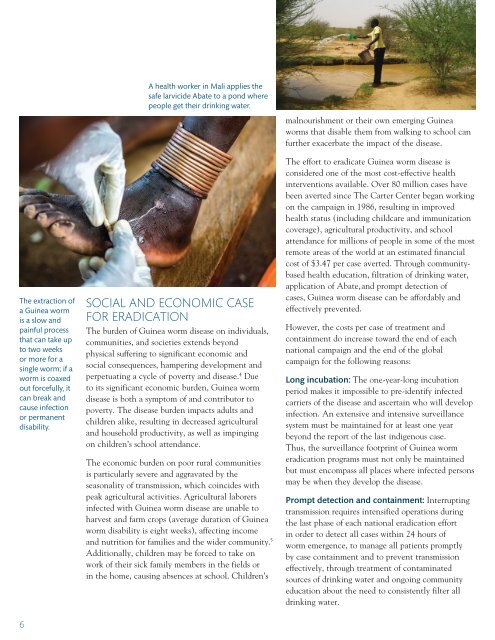ERADICATION OF GUINEA WORM DISEASE
1o72uNl
1o72uNl
Create successful ePaper yourself
Turn your PDF publications into a flip-book with our unique Google optimized e-Paper software.
The extraction of<br />
a Guinea worm<br />
is a slow and<br />
painful process<br />
that can take up<br />
to two weeks<br />
or more for a<br />
single worm; if a<br />
worm is coaxed<br />
out forcefully, it<br />
can break and<br />
cause infection<br />
or permanent<br />
disability.<br />
6<br />
A health worker in Mali applies the<br />
safe larvicide Abate to a pond where<br />
people get their drinking water.<br />
SOCIAL AND ECONOMIC CASE<br />
FOR <strong>ERADICATION</strong><br />
The burden of Guinea worm disease on individuals,<br />
communities, and societies extends beyond<br />
physical suffering to significant economic and<br />
social consequences, hampering development and<br />
perpetuating a cycle of poverty and disease. 4 Due<br />
to its significant economic burden, Guinea worm<br />
disease is both a symptom of and contributor to<br />
poverty. The disease burden impacts adults and<br />
children alike, resulting in decreased agricultural<br />
and household productivity, as well as impinging<br />
on children’s school attendance.<br />
The economic burden on poor rural communities<br />
is particularly severe and aggravated by the<br />
seasonality of transmission, which coincides with<br />
peak agricultural activities. Agricultural laborers<br />
infected with Guinea worm disease are unable to<br />
harvest and farm crops (average duration of Guinea<br />
worm disability is eight weeks), affecting income<br />
and nutrition for families and the wider community. 5<br />
Additionally, children may be forced to take on<br />
work of their sick family members in the fields or<br />
in the home, causing absences at school. Children’s<br />
malnourishment or their own emerging Guinea<br />
worms that disable them from walking to school can<br />
further exacerbate the impact of the disease.<br />
The effort to eradicate Guinea worm disease is<br />
considered one of the most cost-effective health<br />
interventions available. Over 80 million cases have<br />
been averted since The Carter Center began working<br />
on the campaign in 1986, resulting in improved<br />
health status (including childcare and immunization<br />
coverage), agricultural productivity, and school<br />
attendance for millions of people in some of the most<br />
remote areas of the world at an estimated financial<br />
cost of $3.47 per case averted. Through communitybased<br />
health education, filtration of drinking water,<br />
application of Abate, and prompt detection of<br />
cases, Guinea worm disease can be affordably and<br />
effectively prevented.<br />
However, the costs per case of treatment and<br />
containment do increase toward the end of each<br />
national campaign and the end of the global<br />
campaign for the following reasons:<br />
Long incubation: The one-year-long incubation<br />
period makes it impossible to pre-identify infected<br />
carriers of the disease and ascertain who will develop<br />
infection. An extensive and intensive surveillance<br />
system must be maintained for at least one year<br />
beyond the report of the last indigenous case.<br />
Thus, the surveillance footprint of Guinea worm<br />
eradication programs must not only be maintained<br />
but must encompass all places where infected persons<br />
may be when they develop the disease.<br />
Prompt detection and containment: Interrupting<br />
transmission requires intensified operations during<br />
the last phase of each national eradication effort<br />
in order to detect all cases within 24 hours of<br />
worm emergence, to manage all patients promptly<br />
by case containment and to prevent transmission<br />
effectively, through treatment of contaminated<br />
sources of drinking water and ongoing community<br />
education about the need to consistently filter all<br />
drinking water.


